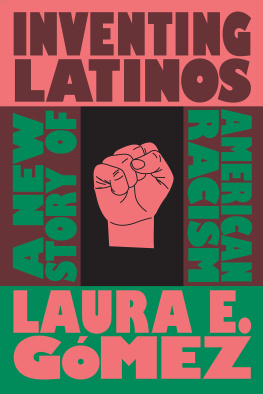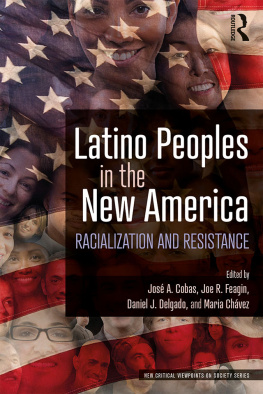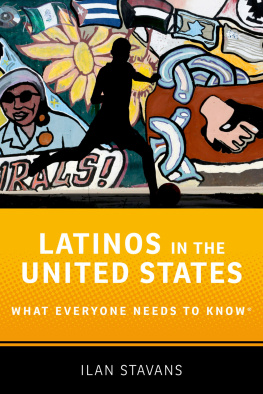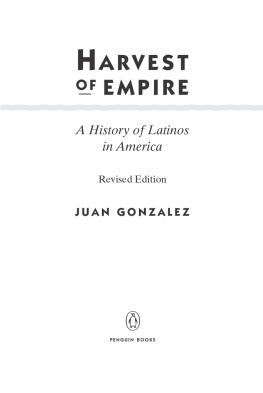
INVENTING LATINOS
Also by Laura E. Gmez
Manifest Destinies: The Making of the Mexican American Race
INVENTING
LATINOS
A NEW STORY OF AMERICAN RACISM
LAURA E. GMEZ

For you, Dad.
For always being there for me;
for feeding my body, mind & soul;
for astute editing over four decades & finding the best cover art for books;
for encouraging me with lists of book titles before a word was written;
for always reminding me that, no matter where we are, were under the same moon.
CONTENTS
INVENTING LATINOS
INTRODUCTION
C ongresswoman Alexandria Ocasio-Cortez, age thirty, represents New Yorks 14th congressional district, including parts of the Bronx and Queens. The districts population, just short of 700,000, is 50 percent Latino, with Whites, Asian Americans, and African Americans each composing 12 to 18 percent. AOC, as she is known, is a member of the Democratic Socialists of America and has captured national attention as the youngest woman ever elected to Congress. She describes her race as reflecting many different identities. I am the descendant of African slaves. I am the descendant of Indigenous people. I am the descendant of Spanish colonizers. That doesnt mean Im Black, that doesnt mean Im Native. But I can tell the story of my ancestors. AOC was born in the Bronx to a Puerto Rican father also born in the Bronx and a mother born in Puerto Rico, who said AOC grew up speaking her mind in family dinner conversations.
Congressman Ben Ray Lujn, forty-eight, represents New Mexicos 3rd congressional district, spanning northern New Mexico from Santa Fe to the Colorado border, west to Arizona, and east to Texas. The districts 700,000 people are 40 percent Latino, nearly 20 percent Native American, and 36 percent White. Lujn was born in the village
Despite their different registers, AOC and Lujn represent Latinx politicians who came of age when the singularity of Latinosas distinct from non-Hispanic Whites and non-Hispanic Blacks, to use those ubiquitous, bureaucratic termsis legible on the national stage.political career; he spoke Spanish fluently and was born at San Ildefonso Pueblo (as were his parents), yet insisted he was White.
Rangel and the elder Lujn came of age when racial identity in America was a dichotomous choice, at least in the public spherewhere one had to choose White or Black. This is not to claim people had less complicated identities in the past or to deny how racism constrained their choices. It is to acknowledge, however, how utterly different things are today. Few would contest the multiplicity of racial identities and racial categories in contemporary America. It is especially the case that Americans have more choices about how to present their difference, however they define ithow they choose to convey (or veil) their identities in particular situations.
Inventing Latinos interrogates the how and why of Latinx identity becoming a distinctive racial identity. To say Latinos have different choices, individually and collectively, is to underline how race reflects two intersecting vectors. On the one hand, one can assert, and so essentially choose, a racial identity; but, on the other, racial identities are given to us by others. We might make a particular choice, but it could be disregarded by anyonefrom a stranger to a police officer deciding whether or not you belong in a particular neighborhood to a government clerk filling out race on a death certificate (because she is uncomfortable asking next of kin the question). In other words, ones choice is constrained in many ways, just as it is for other identities. But to accurately describe racial identity as situational does not fully capture the social dynamic at the heart of this book, which has as much to do with how racial conventions and racism make some peoples race less malleable than others. It is equally the case that not everyones opinion of your race is equally relevant; the cops opinion matters more than the strangers, although the latter might be a gateway to the former. So far, these examples have focused on individual interactions, or what sociologists call the micro level.
This books concern is mostly with two additional levels, the meso level and the macro level, and with how the three levels interact together. For instance, if we consider an institutional context like schooling, we know there is a particular set of ideas about race and racial classification, though, to be sure, these ideas vary and circulate in different ways. We know that it is routine in the United States for teachers, parents, and school administrators to talk about race in a demographic register (say, the make-up of the school or community) as well as a cultural register. Most often, the latter treats race in coded ways that value a color-blind notion of racethe notion that race is irrelevant to the content of ones character, viewpoints, and the like. The most abstract level, and sometimes the hardest one to pin down, is the macro, relating to social structure that is immune from individual manipulation. When we think of broad-scale social realities that shape race and racial classification, these are probably macro dynamics; examples would be the way neighborhood boundaries in a large city reflect decades of racial patterns, including explicit rules limiting what racial groups could live in particular areas; decisions by generations of city officials about where to build freeways, refuse centers, parks, and wide boulevards; decisions by private-sector actors like banks, grocery stores, and owners of rental housing about doing business in particular neighborhoods, and so on.
Websters defines the word invent as to originate or create as a product of ones own ingenuity, experimentation, or contrivance; for example, to invent the internet. While that definition does not apply here, the successive two dictionary definitions do: to produce or create with the imagination and to make up or fabricate (something fictitious or false). This book explains how and why Latinos became cognizable as a racial groupa racial group that is other and inferior to Whites. The third definition applies, though not because this book In other words, what we as interacting humans make up, create, or invent has power in our lives. To put it more bluntly: race isnt real, but racism is.
This book is less about how individual Latinos express their identity and more about where Latinos are, collectively, in the American racial system. Overall, the system of racial classification, rooted in American history, exists to maintain white supremacy. This has been the case even when the power structure dominated by Whites has bowed to pressure to protect the civil rights of African Americans and other people of color, whether during postCivil War Reconstruction or during what some call the second Reconstruction, the mid-twentieth-century enactment of the Civil Rights Act and Voting Rights Act. Racialization is how society and the state assign individuals to racial groups and the relative position of groups to each otherand it is an important aspect of this story. Racism requires racial categories and mechanisms for sorting people into them. Some mechanisms, like the U.S. census, are formally conducted by the state and tightly regulated by law. Other mechanisms, such as popular culture, are diffuse in terms of production and consumption, but no less powerful. These two examples reflect the two sides of racial sorting: assignment is when institutions classify people into racial categories, and assertion is when individuals racially define themselves.
Next page








